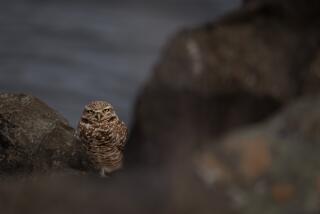Genome study unmasks evolution of Darwin’s finches
A genome study of the famed Darwin finch species on the Galapagos and Cocos islands has unveiled a gene behind the 15 species’ remarkable variation of beaks, a feature that helped inspire the father of evolutionary theory.
The study of 120 individual birds from across the South American island chain finds that a single species radiated into more than a dozen others over the past million years, a change fueled by hybridization.
The wide variety of beak shape and size among finches on the archipelago has become an iconic foundational story behind Charles Darwin’s “On the Origin of Species,” published in 1859 -- even though he misidentified them at first and gave them scant mention in the treatise. But they have come to represent a textbook example of how species develop through random variation and the forces of natural selection.
“He wrote that it looked like this was one species that changed into multiple species, and particularly through the change of the beak shape to utilize food,” said Uppsala University geneticist Leif Andersson, co-author of the study published online Wednesday in the journal Nature. “Our data fit perfectly with that.”
British biologist Peter and Rosemary Grant, of Princeton University, have spent 40 years studying the subtle changes in the birds, and published a startling example of natural selection unfolding among a pair of species on one of the islands. The two are co-authors of the current report, which used some of the DNA samples they collected.
“You can imagine how satisfying it is for us after all those years in the field to be able to discover a gene that underpins our findings of evolution by natural selection,” Peter Grant said.
The gene, called ALX1, is located on a swath of the genome whose coding has been remarkably consistent for ages, until changes altered the production of four proteins, and that gene variation came to dominate.
“As many changes that have occurred over 300 million years have occurred during the last million years on the Galapagos,” said Andersson.
The finches are descended from a sharp-billed South American tanager that arrived on the islands about 1.5 million years ago, according to the study. Warbler finches split earliest, about 900,000 years ago, with ground and tree finches constituting the most recent radiation, about 100,000 to 300,000 years ago, according to the study.
But during that time, there was much interbreeding that allowed genes to flow across species, leaving them with a wide variety of beak sizes and shapes, the study suggests.
“We were able to demonstrate that there has been hybridization going on between the different species throughout their evolution,” Andersson said. “You could even see that it must have occurred back a million years ago.”
The mixed heritages were striking among species of Geospiza difficilis found on six different islands, according to the study, which reclassified them into three distinct groups. In addition, bird species that were genetically similar on one island were not as closely related on others, the study also notes.
Suggestions of hybridization between different species can stir controversy because age-related anomalies in segments of the genome can be interpreted as evidence of interbreeding, or just signs of variations within a population.
The study resolves the issue well, said Thomas Gilbert, head of the evolutionary genomics section of the Natural History Museum of Denmark, who was not involved in the study.
Experiments might be required to confirm the findings on the gene underlying beak changes, he added.
Biologist Peter Boag, a genetics specialist at Queen’s University in Kingston, Canada, said the study “shows in the greatest detail yet how messy the recent evolutionary history of the tree and ground finches has been.”
But it’s that very mess of adaptations oscillating from sharp to blunt beaks and back that makes the Galapagos such an important laboratory for probing evolution, said Boag, who collaborated with the Grants in some of their early research.
“We have a system of islands that are just ecologically different enough, and just far enough apart to allow populations to become genetically distinct quite quickly as birds adapt to local circumstances,” he said. “Then as circumstances change, the influx of new gene combinations by hybridization appears to facilitate the rapid evolution” of new traits and behaviors.
“As humans we want to draw fixed boxes called ‘species x’ vs. ‘species y’ around the major players of this complex evolutionary game, but the reality is that the variation and change are what matters,” Boag said.
Is science in your DNA? Follow me on Twitter: @LATsciguy







